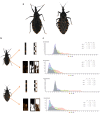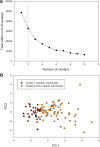Characterization of melanic and non-melanic forms in domestic and peridomestic populations of Triatoma infestans (Hemiptera: Reduviidae)
- PMID: 32014037
- PMCID: PMC6998255
- DOI: 10.1186/s13071-020-3912-y
Characterization of melanic and non-melanic forms in domestic and peridomestic populations of Triatoma infestans (Hemiptera: Reduviidae)
Abstract
Background: Melanic (dark) morphs have been barely reported in peridomestic and sylvatic conditions for Triatoma infestans, the most important vector of Chagas disease in the Southern Cone of South America. Adults with dark and small yellow markings on the connexivum were collected after manual searches conducted by technical personnel in 62 domiciliary units in Cruz del Eje, Córdoba Province, Argentina. The last community-wide insecticide spraying campaign before the study had been conducted three years earlier. We investigated if there was a measurable color morph variation (melanic and non-melanic) in wings and connexivum; we determined infestation, distribution of melanic and non-melanic forms, and correspondence of colorimetric variation with variations in morphology (wing size and shape and body length), development (wing fluctuating asymmetry), physiology (nutritional status) or behaviour (flight initiation).
Results: Forty-nine females, 54 males and 217 nymphs were collected in 24 domiciliary units. House infestation and colonization were 53% and 47%, respectively. Most of the T. infestans individuals (83.2%) were collected in chicken coops; intradomicile infestation was recorded in only one case. The chromatic cluster analysis showed two well-defined groups: melanic and non-melanic. The melanic group included 17 (35%) females and 25 (46%) males. Peridomestic infestation was lower for melanic than for non-melanic adults. Melanic morphs were collected in houses from several localities. Sexual dimorphisms were confirmed by morphometric measurements. Body length was large in melanic adults (P < 0.01 only for males). Differences between groups were significant for wing size and shape, but not for weight or weight/body length ratio. Melanic females and males showed significantly higher fluctuating asymmetry (FA) indices than their non-melanic counterparts.
Conclusions: This is the second report of melanic forms of T. infestans in domestic and peridomestic habitats in the Dry Chaco region of Argentina. Although non-melanic adults exhibited a higher infestation rate, melanic adults were widespread in the area and were collected in the infested domicile and in most types of peridomestic annexes. Differences in morphometric variables between groups might be due to different ecological adaptations. The higher FA levels observed in melanic individuals suggest a higher developmental instability and a selective advantage of non-melanic individuals in domestic and peridomestic habitats.
Keywords: Colorimetric analysis; Developmental instability; Flight initiation; Melanic/non-melanic; Morphological differences; Selective advantage; Triatoma infestans.
Conflict of interest statement
The authors declare that they have no competing interests.
Figures





Similar articles
-
Phenotypic variability and population structure of peridomestic Triatoma infestans in rural areas of the arid Chaco (Western Argentina): spatial influence of macro- and microhabitats.Vector Borne Zoonotic Dis. 2011 May;11(5):503-13. doi: 10.1089/vbz.2009.0253. Epub 2010 Oct 6. Vector Borne Zoonotic Dis. 2011. PMID: 20925525
-
Hidden sylvatic foci of the main vector of Chagas disease Triatoma infestans: threats to the vector elimination campaign?PLoS Negl Trop Dis. 2011 Oct;5(10):e1365. doi: 10.1371/journal.pntd.0001365. Epub 2011 Oct 25. PLoS Negl Trop Dis. 2011. PMID: 22039559 Free PMC article.
-
Fluctuating asymmetry and exposure to pyrethroid insecticides in Triatoma infestans populations in northeastern Argentina.Infect Genet Evol. 2019 Oct;74:103925. doi: 10.1016/j.meegid.2019.103925. Epub 2019 Jun 17. Infect Genet Evol. 2019. PMID: 31220610
-
The peppered moth and industrial melanism: evolution of a natural selection case study.Heredity (Edinb). 2013 Mar;110(3):207-12. doi: 10.1038/hdy.2012.92. Epub 2012 Dec 5. Heredity (Edinb). 2013. PMID: 23211788 Free PMC article. Review.
-
The rise and fall of the Carbonaria form of the peppered moth.Q Rev Biol. 2003 Dec;78(4):399-417. doi: 10.1086/378925. Q Rev Biol. 2003. PMID: 14737825 Review.
Cited by
-
Where you live shapes who you are: morphological changes in urban Triatoma infestans.Front Insect Sci. 2025 Jun 2;5:1593921. doi: 10.3389/finsc.2025.1593921. eCollection 2025. Front Insect Sci. 2025. PMID: 40530169 Free PMC article.
-
The Body of Chagas Disease Vectors.Pathogens. 2025 Jan 20;14(1):98. doi: 10.3390/pathogens14010098. Pathogens. 2025. PMID: 39861059 Free PMC article. Review.
-
Chromatic and Morphological Differentiation of Triatoma dimidiata (Hemiptera: Reduviidae) with Land Use Diversity in El Salvador.Pathogens. 2021 Jun 14;10(6):753. doi: 10.3390/pathogens10060753. Pathogens. 2021. PMID: 34198542 Free PMC article.
-
Morphofunctional characteristics of flight-related traits in deltamethrin-resistant and susceptible Triatoma infestans (Klug, 1834) of the Argentinean Chaco.Parasit Vectors. 2025 Mar 6;18(1):92. doi: 10.1186/s13071-025-06678-2. Parasit Vectors. 2025. PMID: 40045385 Free PMC article.
References
-
- True JR. Insect melanism: the molecules matter. Trends Ecol Evol. 2003;18:640–647. doi: 10.1016/j.tree.2003.09.006. - DOI
-
- Majerus MEN. Melanism: evolution in action. 1. New York: Oxford University Press; 1998.
-
- Safranek L, Riddiford LM. The biology of the black larval mutant of the tobacco hornworm. Manduca sexta. J Insect Physiol. 1975;21:1931–1938. doi: 10.1016/0022-1910(75)90225-5. - DOI
MeSH terms
Substances
Grants and funding
LinkOut - more resources
Full Text Sources

